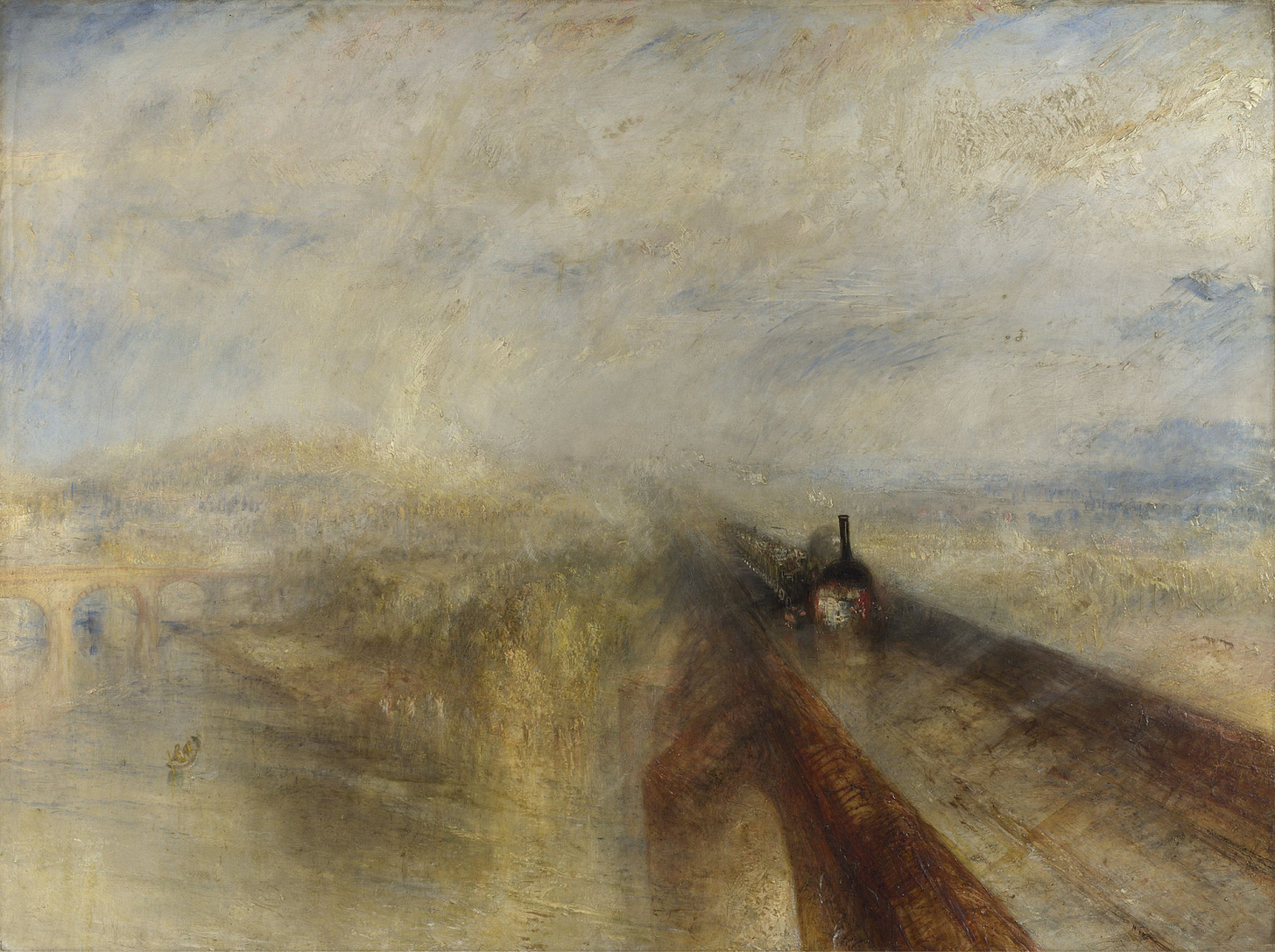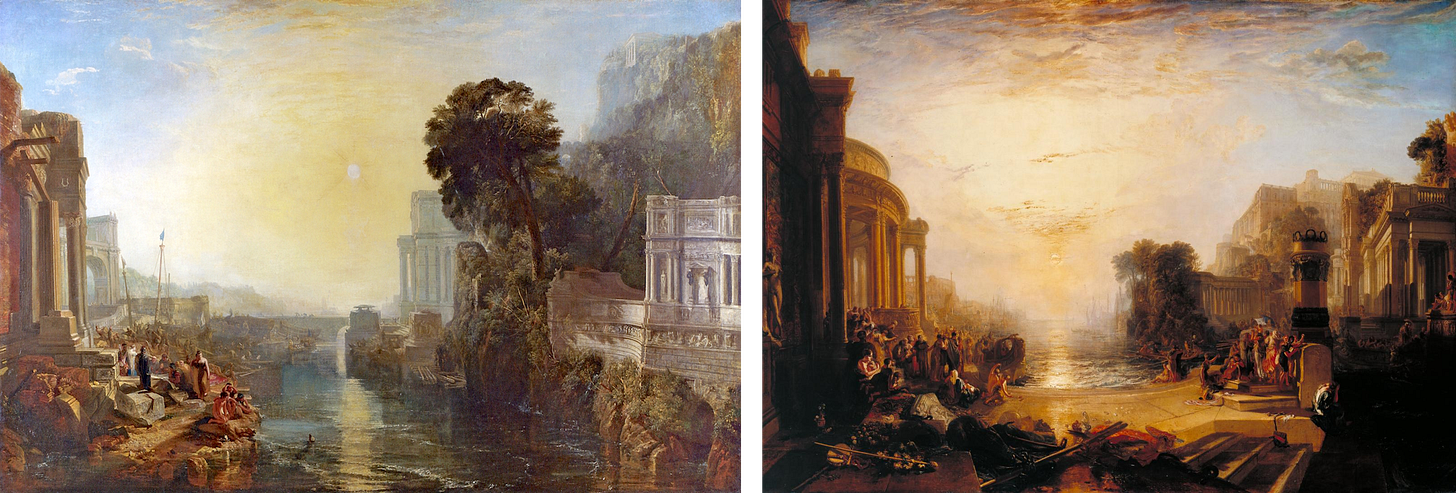a year without summer
on JMW Turner and volcanoes
The first time a painting ever made me cry was in 2018, at the National Gallery in London. JMW Turner's Rain, Steam, and Speed (1844) was on display. When I spotted it from across the room, paired with another one of his works, my eyes immediately started to well up. Decades before impressionism took the world by storm, Turner had been creating incredible, abstracted landscapes that somehow seemed more detailed than the photorealistic works of his peers. Sea mist and refracted light obscured details in his paintings, creating pieces that were affecting in a way traditional landscapes weren't. A true member of the Romantic movement, he sought to use his non-traditional brushstrokes to highlight the sublime, the awe-inspiring grandeur of nature that was evidence of God's power. His search for spirituality in the world led him to look beyond what he saw, incorporating the atmospheric perspective that he came to be known for and that made him one of the greatest artists of his era.
What made me cry wasn't any of this intellectualization. That came before and after. The work itself had an incredible effect, a unique presence in that room, contrasting against the maroon wall behind it, something like what Walter Benjamin would call aura. At once, I could see the figures but also feel how Turner experienced the world in that moment: both amazed by the shifting nature of the sea and the atmosphere and cautiously interested in how the technological advancements in bridge-building and railroads seemed to fit into it. This is the beautiful, awestriking world, the pigment seemed to whisper, as much as I can understand it.
Two hundred and three years earlier, a volcano named Mount Tambora in present-day Indonesia erupted. Sounds like explosions filled the air for weeks on end, audible thousands of miles away. Volcanic ash filled the atmosphere from what would be the most powerful volcanic eruption in recorded human history.
This eruption made 1816 come to be known as the Year without a Summer, due to a volcanic winter — a global drop in temperatures as a result of the sulfuric acid in the atmosphere. The sun was obscured for months on end. The phrase itself is ominous. Imagine missing a season, as essential as fingers of a hand. The Year without a Summer led to crop failures and food shortages, famine and migrations, floods and disease. Through an act of God, the world became less habitable for over a year, and all man could do was watch.
Among the strife caused by the eruption of Mount Tambora, there were unexpected consequences. The sunrises and sunsets were different, beautiful even. They were redder and darker, more ominous than hopeful, yet still striking in their changes. Landscapes painted by artists including JMW Turner immediately after reflected this reality, and all these years later, we can imagine what it was like to experience the change in the waning sun each day.
Before and after the year without a summer, Turner painted two views of the historical city of Carthage. The first, Dido of Carthage (1815), is more figurative and hopeful, while the latter, The Decline of the Carthaginian Empire (1817), focuses more heavily on the reddish sunset, colored by tephra in the air. The sky and the choppy sea draw the eye in, leaving the men and their buildings as simply witnesses to the grandeur. The shapes of the clouds and the intense colors foreshadow the atmosphere that would define his later work.
This period of Turner's career was defined by experimentation with new colors and pigments, perhaps in attempts to capture the changing skies, and his work would only continue to evolve over the coming years. He was obsessive when it came to his work, known to refer to his works as his children. And over the course of his life, he produced a city's worth of children: hundreds of oil paintings, thousands of watercolors, tens of thousands of works on paper. In his 76 years of life, he was dedicated to his craft and his reverence for nature over all else In his single-minded focus, he generated incredible work, and not just from an artistic perspective.
One fascinating study referenced hundreds of works of artists from 1500 to 1900 to estimate the air conditions of different parts of the world before and after volcanic eruptions (including Mount Tambora) throughout history, heavily influenced by the color usage in their depictions of the sky. Without knowing it, these artists served as atmosphere scientists, so dedicated to accurately representing nature that they gave scientists a more effective record of volcanic effects on the climate throughout history. 181 painters' works were considered for the study, and ultimately 327 paintings were used.
Of those 327 paintings analyzed for this study, 119 of them were made by Turner. Due to his prolific output, his consistency in capturing light appropriately, and his long career, no one's work was a better contender for scientific analysis than his was. He had long been heralded as one of the greatest painters of his era, but centuries later he was a scientist too, thanks to the pains he took to capture the sunsets faithfully.
What made me cry at the National Gallery is what often makes me cry — the rendering of effort, love, obsession. At that moment, I didn't know this much about Turner, but his effort shone through the work itself. The mastery was obvious in its construction, in its ability to evoke such feeling when the majority of the canvas hardly depicts anything at all, other than colors of the sky, or the sea. There was a magic conjured by the effort, something invisible and powerful gained by the repeated brushstrokes over decades, over thousands of canvases and sheets of paper. This magic struck me like a truck in that museum, inspiring me more than ever about what commitment to a vision can do.
Rain, Steam, and Speed was completed seven years before Turner would pass away, near the end of a luminous life dedicated to art, at a time when he had honed his skills and developed his defining style. His work had reached its zenith, even as his life's light had long begun its descent. In his purported last words, he continued to revere the deity that he had spent so much time painting, saying, “The sun is God.” And, to him, it always was.
💧 Drops of the Week 💧
PLAYLIST - housewarming - we had a housewarming; these were the songs we played.
POEM - “The Plum You’re Going to Eat Next Summer” by Gayle Brandeis - The plum you’re going to eat next summer / doesn’t exist yet




I will be looking at a lot of Turners on the interwebs for the next few days; I'm educated just enough to recognize his name, but that's about it. Fascinating about the volcano, artists, and sunrises and -sets. Thanks!
beautiful - makes me want to see a Turner in person.